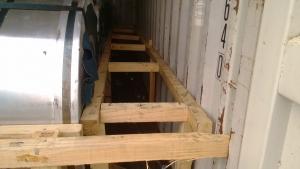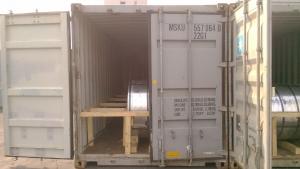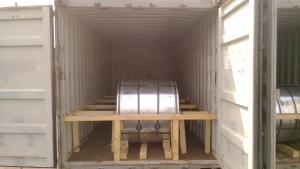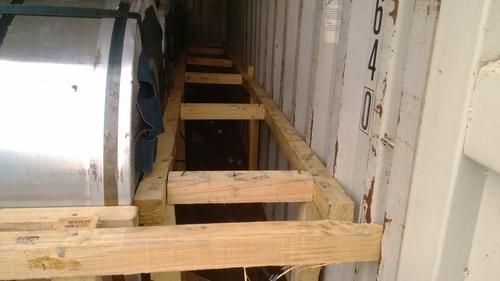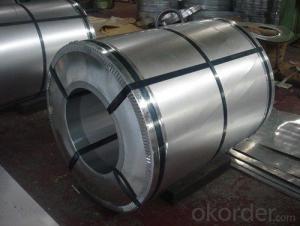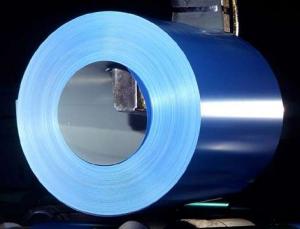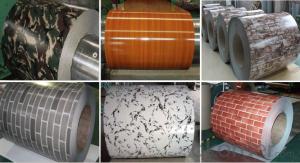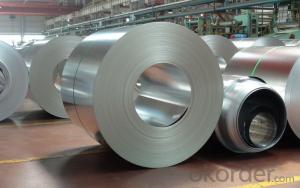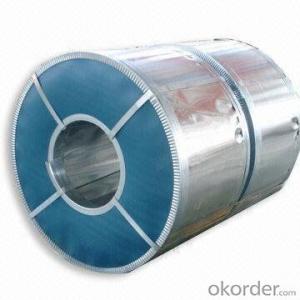EU standard Hot Dipped Galvanized Steel Coil
- Loading Port:
- China Main Port
- Payment Terms:
- TT OR LC
- Min Order Qty:
- -
- Supply Capability:
- -
OKorder Service Pledge
Quality Product, Order Online Tracking, Timely Delivery
OKorder Financial Service
Credit Rating, Credit Services, Credit Purchasing
You Might Also Like
EN10327 DX51D, Z80, REGULAR SPANGLE, CHROMATED & UNOILED
SIZE (MM) (TCT) MOQ (MTS)
0.50 x 1000 x C 60
0.60 x 1200 x C 60
0.77 x 1000 x C 60
0.77 x 1200 x C 60
0.97 x 1250 x C 60
1.21 x 1200 x C 60
1.21 x 1000 x C 60
1.97 x 1200 x C 60
COIL ID: 610MM
COIL WEIGHT: 5-15MTS
PAYMENT: 100% LC AT SIGHT OR T/T DOWNPAYMENT
LOADING PORT: TIANJIN, CHINA
SHIPMENT: 75 DAYS AFTER LC ISSUING DATE
- Q: What are the challenges in coil recoiling for high-strength steel?
- One of the main challenges in coil recoiling for high-strength steel is the control and management of residual stresses. High-strength steel has a tendency to retain significant levels of residual stresses, which can lead to coil distortion or springback during recoiling. This requires careful process optimization and control to minimize these effects. Additionally, the high strength of the steel can make it more susceptible to cracking or damage during recoiling, necessitating precise handling techniques and equipment. Overall, the challenges lie in achieving uniform coil geometry, minimizing residual stresses, and avoiding any potential damage to the high-strength steel during the recoiling process.
- Q: Can steel coils be used in the production of medical equipment?
- Medical equipment production often incorporates steel coils. Steel, being a versatile material, is renowned for its strength, durability, and ability to withstand diverse environmental conditions. It is frequently employed in the manufacture of medical equipment such as surgical instruments, orthopedic implants, hospital beds, and diagnostic machines. The usage of steel coils as raw materials is commonplace in the production process. They can be processed and shaped into a multitude of forms, sizes, and components essential for medical equipment. By cutting, shaping, and welding the coils, intricate parts with precise specifications can be crafted, guaranteeing the quality and performance of the final product. Additionally, steel coils can undergo surface treatment to enhance their resistance to corrosion. This makes them appropriate for use in medical environments where cleanliness and hygiene are crucial. Electroplating or powder coating can be applied as protective coatings, offering an extra layer of defense against rust and other forms of degradation. Moreover, steel proves to be a cost-effective material, making it an appealing choice for manufacturers of medical equipment. Its availability and affordability render it a preferred option for producing high-quality medical devices while managing production costs. To summarize, the utilization of steel coils in the production of medical equipment is indeed viable. Their strength, durability, versatility, and cost-effectiveness make them an ideal selection for manufacturing various components and instruments utilized in the healthcare industry.
- Q: How are steel coils used in the production of wind turbine components?
- Steel coils are used in the production of wind turbine components for their strength and durability. These coils are typically formed into various shapes and sizes to create structural elements such as towers, frames, and foundations. The steel coils are also used to manufacture critical parts like rotor blades, gearboxes, and generator housings, ensuring the turbines withstand harsh environmental conditions and operate efficiently.
- Q: How do steel coils contribute to the automotive manufacturing sector?
- Steel coils are essential in the automotive manufacturing sector as they are used to produce various components such as body parts, frames, and suspension systems. The high strength and durability of steel coils make them ideal for ensuring the safety and structural integrity of vehicles. Additionally, steel coils are easily moldable, allowing manufacturers to create complex shapes and designs, contributing to the overall aesthetics and functionality of automobiles.
- Q: Why is steel a stiff material?I'm doing a project on the use of steel in the construction of skyscrapers - and obviously, for the inner steel skeleton of a skyscraper the steel support beams and girders will have to be stiff so that they don't fall apart or the building doesn't shake due to wind or other natural forces.But in my research I've found that steel (mild steel to be more exact) is ductile and malleable, meaning it can be shaped fairly easily. However, how can steel ALSO be stiff - the definition of stiffness is the tendency to withstand bending and stretching - so my question is. How can this material be BOTH ductile/malleable, AND stiff? and why? :)Thank you in advance if anyone takes the time to answer this, would be appreciated - I'll give you 10 points straight away if the answers conclusive
- Steel is NOT stiff. In fact it is worldly accepted metals (steel is a metal) are not rigid in mechanical terms, and rigid means stiff. Steel easy to shape, but is strong and therefore hard to break. Thermosetting polymers (hard plastic) which is stiff, is in fact easy to break (weak) and also hard to reshape without changing its state (solid to liquid). Whoever told you steel is stiff is wrong and possible meant steel is strong, or you misheard/misunderstood.
- Q: How are steel coils used in the production of automotive stampings?
- Steel coils are an essential component in the production of automotive stampings. These coils are typically made from high-quality steel and are cut into specific widths and lengths to meet the requirements of automotive manufacturers. The first step in using steel coils for automotive stampings is to uncoil the steel. This is done using a machine called a decoiler, which unwinds the coil and feeds it into the stamping machine. The decoiler ensures a continuous supply of steel for the stamping process. Once the steel coil is unwound, it is fed into the stamping machine, which is equipped with a die that shapes the steel into the desired automotive component. The die is designed to create precise and complex shapes, such as car body panels, doors, fenders, or structural components. The stamping machine applies force to the steel coil, pressing it against the die and forming it into the desired shape. The high-quality steel used in the coils ensures that the stamped components have the necessary strength and durability required for automotive applications. After the stamping process, the stamped components are inspected for quality and precision. Any imperfections or defects are identified and corrected before the components are sent for further processing, such as painting, welding, or assembly. Overall, steel coils play a crucial role in the production of automotive stampings. They provide a continuous supply of high-quality steel, which is shaped into precise and durable automotive components. The use of steel coils ensures that the automotive stampings meet the required standards for strength, durability, and precision.
- Q: How can steel coils be recycled?
- Steel coils can be recycled by first removing any contaminants or coatings from the surface. The coils are then shredded into smaller pieces and melted in a furnace. The molten steel is then formed into new coils or other steel products.
- Q: What website can I use to find a good picture that shows the atomic structure of a carbon steel?
- This Site Might Help You. RE: Where can I find an atomic structure of carbon steel? What website can I use to find a good picture that shows the atomic structure of a carbon steel?
- Q: hi i was doing a little history project on guns. i was just wondering if anyone could help me find out what material was used before steel and why this material wasnt as good as steel ( its faults)thanks for your help
- Gunmetal is a specific type of brass
- Q: Okay basically bought my girlfriend Tiffany sterling silver necklace for her birthday and now christmas is coming up i want to buy her this DG Necklace. BUT i have discovered its steel. And its ?110. I am not a rich man i am infact quite young and we have been together for an incredibly long time! I wanted to know is Steel seen as a cheap necklace, whats your say? Don't give me all this bull about her being grateful as she does not expect this. BUT I WANT IT TO BE NICE. Whats your say? Is Steel good? Does it get dirty? Does it shine? Is it worth it? Thanks x
- Steel necklaces are popular these days. They certainly have a different look than silver. I think they have an 'edgier' look, so it depends on your girl's style. If you like it, and you think she will, go for it. If you're into showing emotional affection, you could accompany the gift with some sort of card or note saying something about your love is as strong as steel. She'd probably dig it. I would.
Send your message to us
EU standard Hot Dipped Galvanized Steel Coil
- Loading Port:
- China Main Port
- Payment Terms:
- TT OR LC
- Min Order Qty:
- -
- Supply Capability:
- -
OKorder Service Pledge
Quality Product, Order Online Tracking, Timely Delivery
OKorder Financial Service
Credit Rating, Credit Services, Credit Purchasing
Similar products
Hot products
Hot Searches
Related keywords
